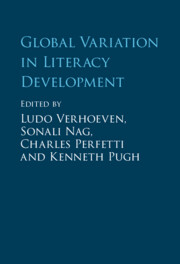Book contents
- Global Variation in Literacy Development
- Global Variation in Literacy Development
- Copyright page
- Contents
- Figures
- Tables
- Contributors
- Abbreviations
- 1 Introduction
- Part I Regional Variations
- Part II Neurobiological and Ecological Markers
- 11 Writing Systems and Global Literacy Development
- 12 Brain Foundations for Learning to Read
- 13 Genetics and Literacy Development
- 14 Role of Self-Regulation in the Transition to School
- 15 Socioeconomic Status, Sociocultural Factors, and Literacy Development
- 16 Sensitivity to Contextual Factors in Literacy Interventions in the Global South
- 17 How Teachers Contribute to Children’s Literacy Success
- 18 The Literacy Ecology of the Home
- 19 Parental Literacy Support in Monolingual and Bilingual Contexts
- 20 Global Literacy
- Index
- References
16 - Sensitivity to Contextual Factors in Literacy Interventions in the Global South
from Part II - Neurobiological and Ecological Markers
Published online by Cambridge University Press: 23 November 2023
- Global Variation in Literacy Development
- Global Variation in Literacy Development
- Copyright page
- Contents
- Figures
- Tables
- Contributors
- Abbreviations
- 1 Introduction
- Part I Regional Variations
- Part II Neurobiological and Ecological Markers
- 11 Writing Systems and Global Literacy Development
- 12 Brain Foundations for Learning to Read
- 13 Genetics and Literacy Development
- 14 Role of Self-Regulation in the Transition to School
- 15 Socioeconomic Status, Sociocultural Factors, and Literacy Development
- 16 Sensitivity to Contextual Factors in Literacy Interventions in the Global South
- 17 How Teachers Contribute to Children’s Literacy Success
- 18 The Literacy Ecology of the Home
- 19 Parental Literacy Support in Monolingual and Bilingual Contexts
- 20 Global Literacy
- Index
- References
Summary
This chapter goes into the sensitivity to contextual factors in literacy interventions in countries in Asia, Africa, Latin America, and other countries that together have been called the Global South. Over the past decades, the measurement of children’s learning has been maturing as a field and has therefore come to be valued as an indicator of success for educational interventions. These have identified literacy and communication as a learning domain and the ability to read as one of the areas of measurement for global tracking. Moreover, the UN Sustainable Development Goals, with the aim of quality education for all by 2030, hashighlighted the need for sensitivity as to what constitutes "quality" and to whom. It is against this background that experiments with literacy interventions in the Global South were reviewed in this chapter. In this review, the focus was on the sensitivity of literacy and foundation learning in developing countries to contextual and cultural factors. The chapter starts with a description of the perspectives that led to the identification of the focus areas in our qualitative analysis. In addition, the methodology of using cultural probes to examine interventions and their evaluation is explicated. Finally, a narrative synthesis of findings and a discussion about the implications for evaluation of the next generation of literacy interventions is provided.
- Type
- Chapter
- Information
- Global Variation in Literacy Development , pp. 353 - 373Publisher: Cambridge University PressPrint publication year: 2023
References
- 1
- Cited by

